Published 08/07/2024.
Through My Backlog, Slowly #1

Welcome to the introductory edition of ‘Through My Backlog, Slowly’, a terribly named newsletter-slash-blogpost where I chat about my thoughts on games I’m either still in the midst of playing, but want to give my thoughts on, or mini-reviews of games that I wouldn’t dedicate an entire review to. Not sure if this format will change, or that I’ll even do a ton of these, but I think this is a good format when I’m between reviews (and neck-deep in writing reviews for The Game Boy Abyss).
For this edition, I’ll be giving my thoughts on a title that’s probably iconic to the childhoods that half the late twenty-somethings of my generation make up - The Simpsons Hit & Run, widely (and rightfully) considered to be the best Simpsons game of all times. It holds up, sure, but for a game twenty-one years old, how well does it hold up? After that, I’ll be having a bit of a ramble about one of the more obscure and old-school games I’ve played thus far this year - Islands of the Caliph, a Muslim faith inspired take on old school, first-person dungeon crawlers. Can pure vibes carry a title like this? Find out! Lastly, it’s probably the most anticipated MMO release of the year - Final Fantasy XIV: Dawntrail. Whilst I’m not nearly into it as far as others, the controversy and general discussion about the expansion’s story quality makes me want to chime in with my thoughts. After two expansions that some claimed reached the apex of quality the Final Fantasy franchise has ever seen, so does Dawntrail match up?
The Simpsons: Hit & Run (Mini-Review)
The impact Simpsons: Hit & Run had on a lot of childhoods cannot be overstated; on a console dominated by three different Grand Theft Auto games changing the entire medium, what naturally followed was a mini-genre of clones, lookalikes and general pale imitations of the game that changed everything. And when you really think about it, how many stood the test of time? The Getaway? True Crime: Streets of LA? The later Driver games? Now, I’m not going to claim that these games are in any way bad, or don’t have their fanbase, but they don’t exist in the public consciousness the way that Hit & Run did. Even to this day, it’s almost universally regarded as the greatest Simpsons game of all time, and there are fans constantly clamoring for a sequel, a remake, or something to come after this bonafide legend of a game. It’s also insane to me that it ‘only’ solid 3 million copies, as this seemed to be one of those games that everyone had played as a kid, especially since it was released on all the big home consoles of the day.
I genuinely believe that no licensed video, before or since Hit & Run, has a greater concentration of references - almost a ‘joke per square meter’ kind of situation. Almost every action in the game, from simply driving somewhere, to running, to even gazing in any particular direction, will reward you with a voice line or visual reference to some part of the then-15 season spanning series. The developers have an almost horrifying reverence to the franchise, enough that I’d consider Hit & Run to be one of the most endearing labors of love I’ve ever seen. Seriously, as someone who, a few years ago, watched all thirty-four seasons (of the time) of the show, there were quotes references that I thought were wholly original, like Homer’s rage about losing his car and all the pennies in the ashtray, were indeed a specific reference. Even the wholly original story - which, by the end, is a bonafide Treehouse of Horror episode - feels true to the cast and the humour that was so iconic to the first twelve-or-so years of The Simpsons, with a lot of heavy lifting done by having much of the original cast return to voice their characters, not missing a single step in the jump from television to video games.
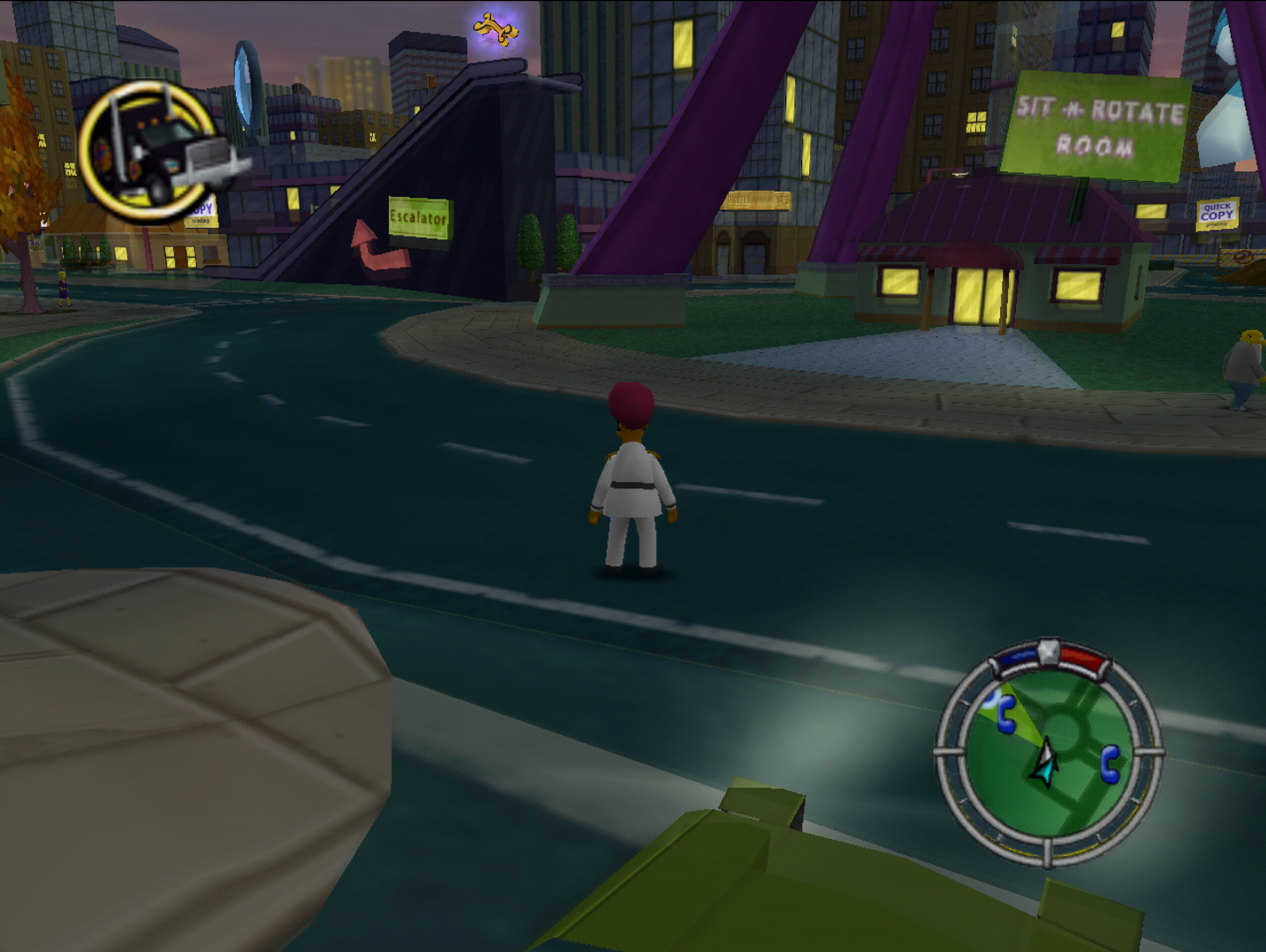
I’ll stop here, because I could seriously write pages about how much I love the writing, voice performances, and generally depiction of the Simpsons’ world, but I’ll just say that before I say anything about this game - being a extremely solid, child-friendly rendition of GTA - Hit & Run is worth playing solely for it’s pure love for the source material, and that goes quadruple for anyone with deep love for the series like I do.
But how does it play? Well, like its inspiration, Hit & Run takes place in relatively open-locales, letting you explore various districts of Springfield at your leisure, whilst completing various tasks and missions to progress the plot, usually involving some kind of vehicular-related devastation. As a kid, I thought these levels - consisting of three zones that are a bit different upon being reused - were gigantic, and I could spend hours just running around my favourite Simpsons areas. Now that I’m older, I can see that these are on the smaller size, but the developers have created enough shortcuts, little back alleys, and miniature puzzles in search of collectibles to really make them feel a lot bigger than they actually are. Plus, there’s a simple joy to be found in finding little sanctuaries like the Kwik-E-Mart’s rooftop garden, or the chessboard in the back of Mr. Burns’ mansion.
My biggest takeaway from playing through Hit & Run again, fifteen years on, is simply how repetitive it is. Now don’t get me wrong; I still had a great time because the car handling is so solid and general open-world is a delight to get lost in, but by the time you reach the fourth or fifth level, you start to realize you’re really just doing the same kinds of tasks, all dressed up in different ways. You’ll almost always be collecting items, albeit just hanging about or dropped from a truck; smashing up an opposing car; and driving somewhere real fast, sometimes against someone, or just against the clock. And the clock really is the true escalation of difficulty in this game; the tasks themselves rarely grow in difficulty, so they just require you to be faster and more efficient, lowering your time or making you work out the most optimized route possible. This is most evident in the last set of missions, which I feel have become almost notorious amongst veterans of this game - because it’s the exact same mission four times in a row, just with harsher time limits. The first two, three levels of the game feel pretty varied, but by the time you’re entering Marge’s level, you’ve pretty much seen everything the game has to offer in it’s main missions - the rest is still fun (for the most part), but if you’re the kind of person looking for a game to keep things fresh, Hit & Run is going to smell rotten to you really, really fast. I’m not going to rant about how much I love the voice acting and Simpsons ‘set-dressing’ the game has, but this would be an average, average game if it looked like a GTA clone, but played the exact same.
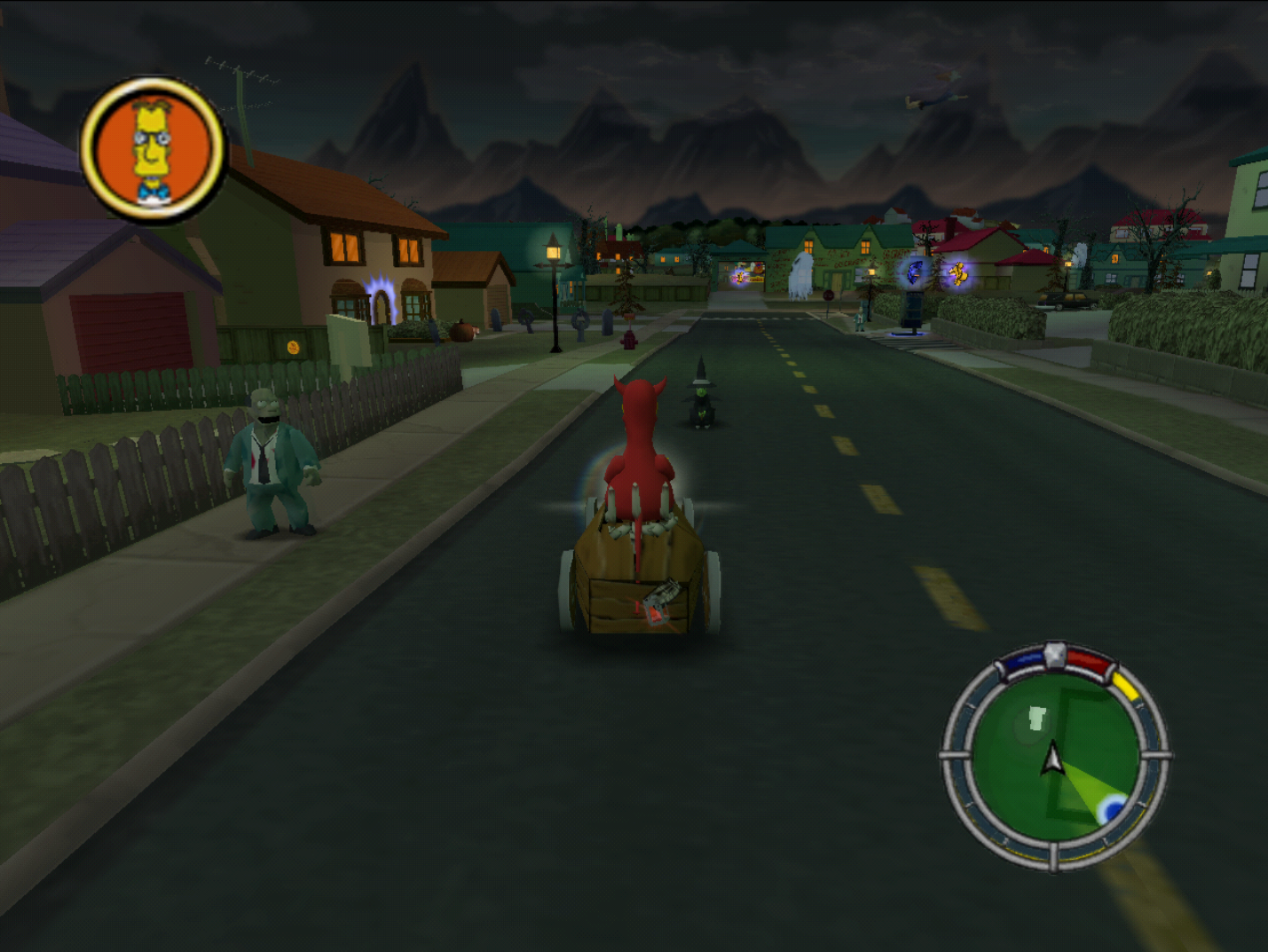
The other major difference on this replay has been actually going for a close-to 100% run of the game. As a kid, I just got the costumes I liked, the cars I was drawn to, and just beat the game For an example, I never knew, just a few doors down from the Simpsons home, you can jump in the backyard of Chief Wiggum’s house! I never, ever found the wasps or collector cards hidden away there, because you never have to go there! These levels were smaller than I remembered, but in my hunt for every coin I could scrounge, every card or wasp I could get my grubby paws on, it helped me see just how well designed everything was. Tricks to get onto rooftops, entire mini-areas, like the traintops or construction areas in Level 2 / 5, or the aforementioned Wiggum backyard in Level 1 / 4 / 7, with these areas frequently holding the last collectibles I needed to hunt down. Optimizing my time with this game, hunting for everything has felt ridiculously satisfying and rewarding to do - I don’t think I ever did one of the wager races as a kid. It’s not a complicated game, hell, it’s generally repetitive, but if you look beyond just the main missions, theres enough here to burn a dozen hours.
Playing Hit & Run a decade and a half on has been nothing short of delightful. To start with, as it’s happened with other ‘beloved’ childhood classics of mine, Hit & Run hold up ridiculously well. I think, and I’d guess many would agree, that what holds Hit & Run so highly in our minds as the greatest Simpsons game ever, is the obviously deep and personal love the developers had for the franchise. Beyond the fantastic usage of the voice cast, the depths they went to create their own, somewhat loony, version of Springfield is nothing short of brilliant. I adore this game, even recognising it’s aged design, and this dozen-or-so hours I’ve spent reacquainting myself with it have been delightful. Goddamn - are there many consoles that can say they aged as well as the PS2?
Islands of the Caliph (Three Hour-in Impression)
I can’t think of a single thing I love more about Steam’s seasonal sales than just stumbling upon those diamonds in a rough, the totally unique, one-man-show titles you’ve never heard about, but pull you in from just a screenshot or a trailer, practically forcing you to buy it, there and then. Usually, I search through the tags of ‘my’ genres - Metroidvanias, dungeon crawlers, stuff like that. As I was searching the latter, Islands of the Caliph appeared on my list; it’s header and cheap price drew me in. And then I took one look at the screenshots, the trailer, and clicked buy, there and then.
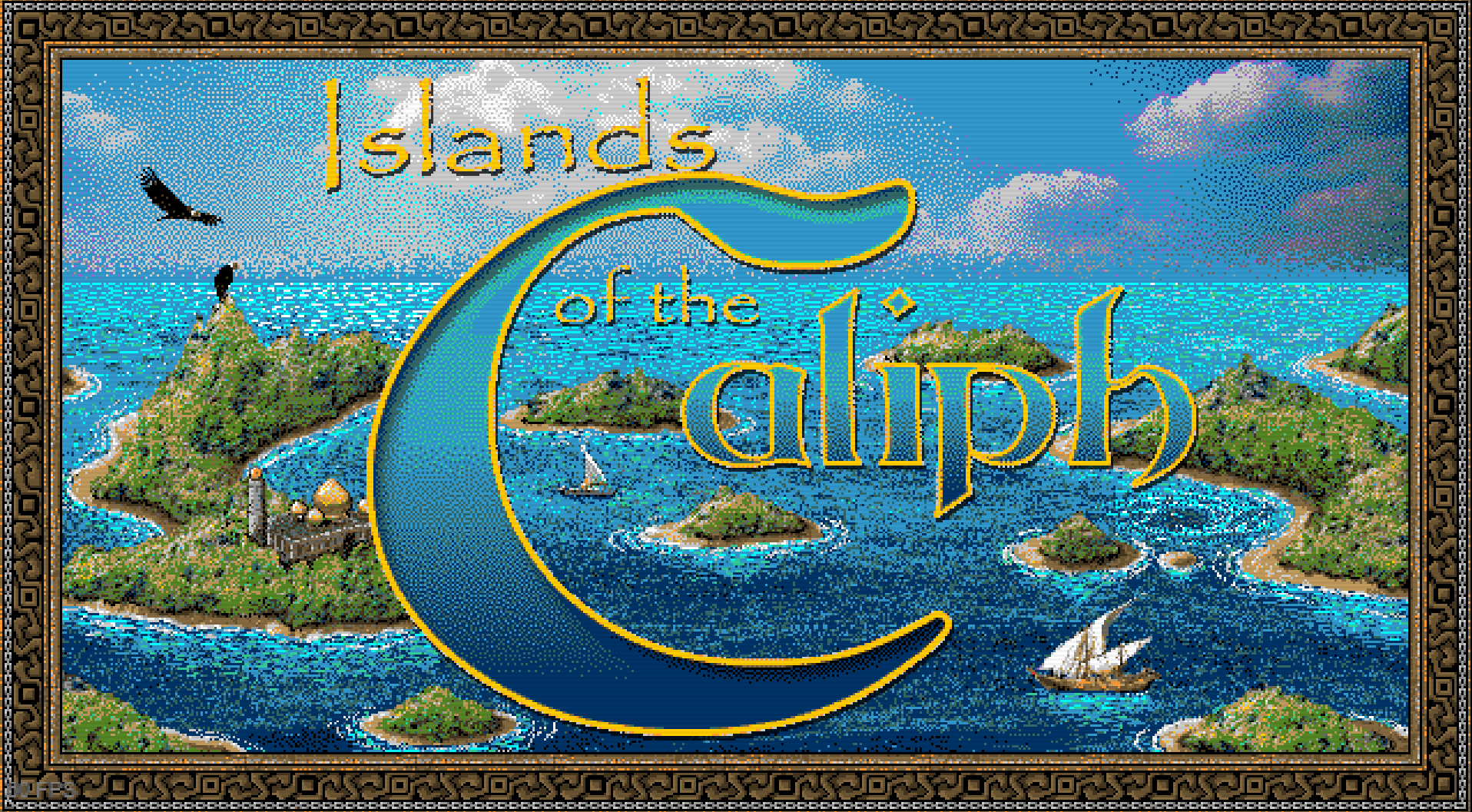
Seriously, how can I begin to talk about how beautiful this game looks? It manages to meet the perfect compromise of having a firm foot in the design aesthetic of it’s inspirations, whilst still keeping it as crisp and clear as if those games of yesteryear were rendered with today’s tech. This, coupled with gentle, subtle tunes, bracketed by the Islamic call to prayer (don’t worry, it’s relevant!) creates an almost dreamlike vibe that pulled me in from the get-go. Enemies and NPCs alike are depicted as gorgeous, 2D sprites that work perfectly in these 3D environments, and sometimes, when the lighting, could genuinely make me catch my breath.
But to the game itself! Islands of the Caliph takes place in a blocky, pixelated world, set across an archipelago rooted in the Islamic faith. If you’ve played Wizadry, one of the classic Might and Magic games, or even glanced in those game directions, you’ll know what you’re in for. It’s structure is similar to other dungeon crawler, grid-based games of the day; wander through maze like towns and dungeons, taking quests from NPCs, hacking away at foes, upgrading your gear and delving into the deep for treasure. The quest design, sadly, is a bit more fetch questy then I’d prefer - go here, get these items, come back, that sort of thing and this, coupled with the fact the majority of NPCs have the same sprite so actually finding the exact guy you promised those coconuts to three islands ago may prove easier said than done. Thank god the vibes are so good, because otherwise I would’ve bounced off this game hard.
Moving on a grid, you’ll explore small, but not tiny, islands that make up the nations of the mostly water locked world; these zones may only take minutes to get the lay of the land of, but have enough quests to complete, dungeons to case, and little nooks and crannies to hunt down. Much of the environment can be carved away to make your own path - trees can be cut down with axes, rocks with hammers, and webs with a torch, giving them a nice bit of progression and reason to return to earlier islands, as you’ll only get certain tools at certain points of your pilgrimage through the archipelago. I’d never call the game complicated, but it’s almost endearing in how simplistic it is. Wandering through dungeons, the light of your torch catching beautifully on the pixel-carved stones, cutting down foes with a few swings of your axe, and getting out with some nice gear - quest-based or not - to boot. All this feels so retro, so relaxing, I can’t help but love it, even if other games like Legends of Grimlock or something like Daggerfall have a bit more going on for them. Islands of the Caliph, again, was made by a single developer, so I can forgive a lack of scope or complexity in the gameplay department when its foundation is so strong.
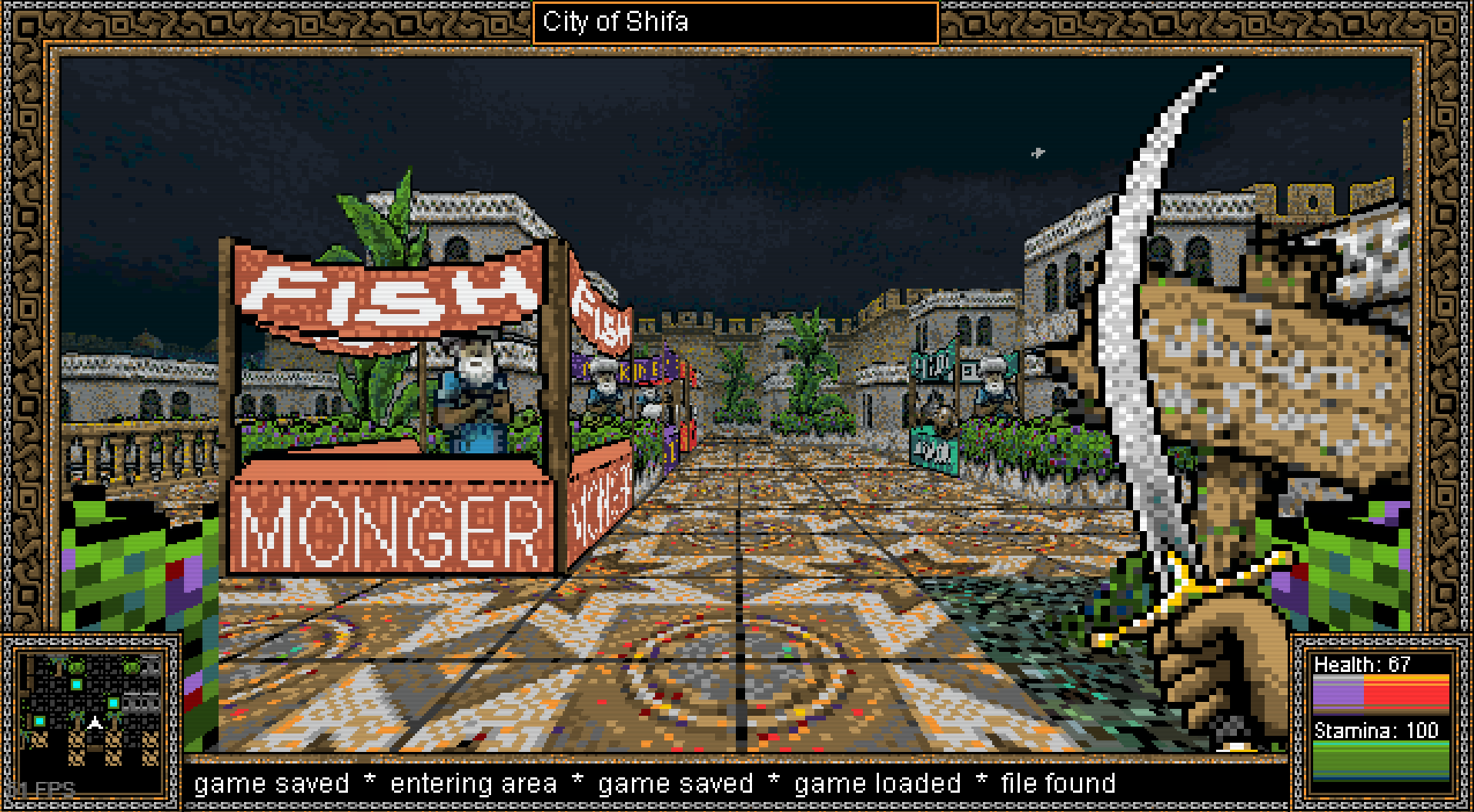
Narratively, though, the game does not have a whole lot going on and that’s a little harder to forgive. Whilst there are tidbits regarding the lore of the world, histories with ghoul-like tribes and the Islamic faith that’s built so deeply into the game, I haven’t found a plot that really pulls me in and really pushes me to explore every inch of the world, but thankfully, the game design is strong enough that I just find myself exploring just for the fun of it. The foundational ideas of the game’s setting and quests are fascinating, I just wish - and hope I’ve just not found it yet - there was more of a main quest then just ‘visit all the islands and say hi to the Sultans’. Notably, the dialogue and text frequently feels janky and awkward to read, giving off the impression that the creator either only speaks English as a second language, or the game is machine translated. Either way, it’s not off putting enough to make the game annoying to read or anything.
Far and away the most interesting element of the game is it’s incredible adherence to the islamic faith, which forms a thick bedrock foundation to the entire game. Every major town has a mosque, though from the jump the implication is that your character is either not a follower of the muslim faith, or they simply don’t know how to worship. Upon learning from an NPC, you are given information pertaining to the traditional times muslims pray, and are then able to either pray in a mosque, or if you can locate one, using a prayer mat. Now, I’m only a few hours into the game, but from what I can tell worship is not a required mechanic, at least in the core questline of the game. If you consistently pray at the correct, traditional times of worship, you’ll be able to earn bonus stat points to spend upon level up, but seemingly upon missing a prayer interval, this bonus will reset. Religion is always a fascinating gameplay element in video games, one that’s seemingly forgotten or barely relevant, and I really, really like the way it’s incorporated into the game here - not required, but a great bonus for one who wants to immerse themselves.
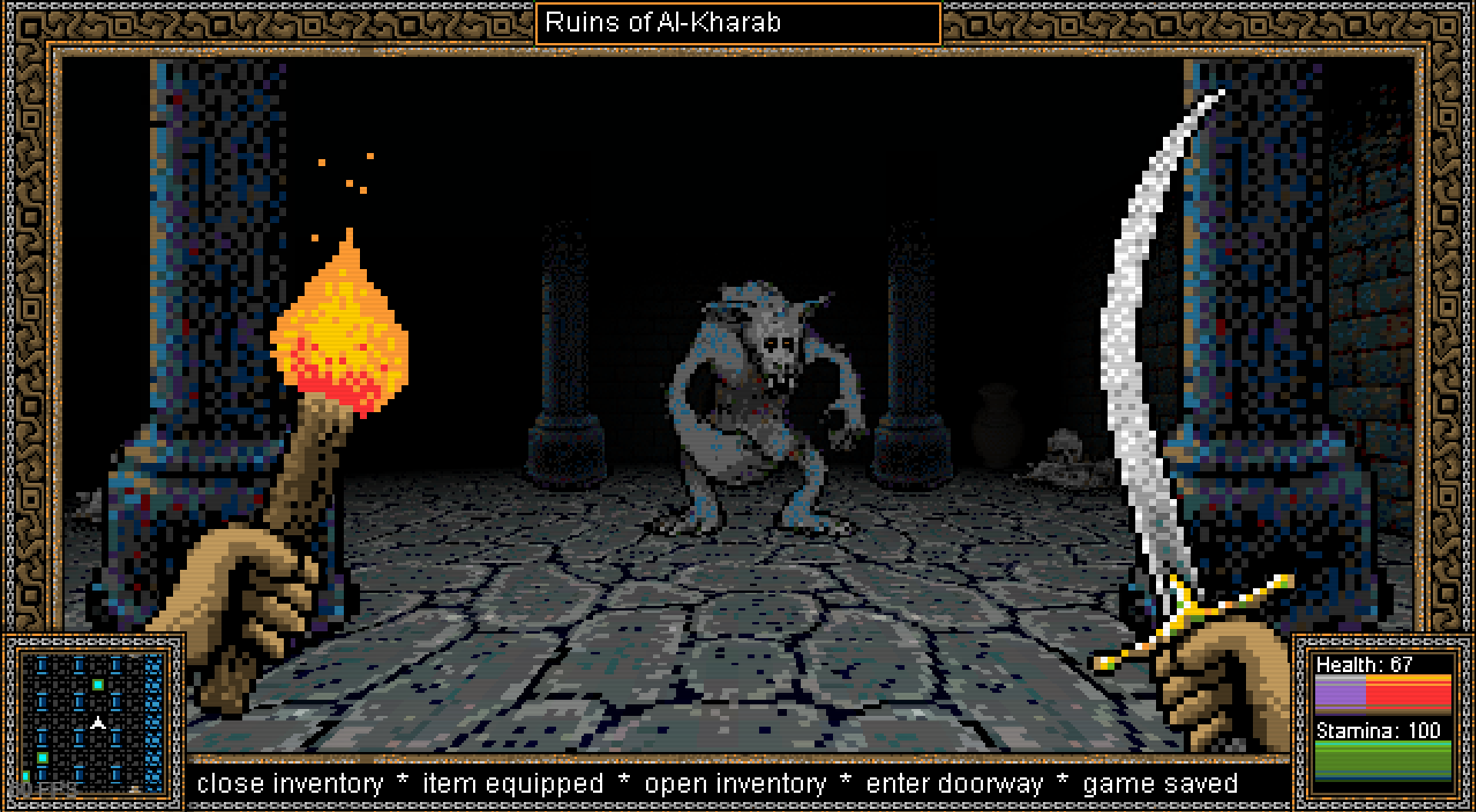
My only real worry about the game is it failing to grow, narratively or mechanically, as I move further in. As I said, So far, a lot of what I’ve been doing is exploring islands, doing relatively benign quests for lords and peasants alike, and exploring the odd dungeon for loot and questing alike. The sheer novelty of the gameplay style, and the beautiful art direction is holding me for now, but I hope there’s some kind of twist, or shake-up in it’s structure along the way. Even if it doesn’t, I think Islands of the Caliph will still keep me satisfied; the fact it’s made by a sole developer, with such a good design aesthetic and such an adherence to his own ideology in a way that doesn’t feel overly restrictive yet still respectful, is nothing short of incredible to me, and I can’t be that mad that it might be more simple than I hope. Still, I want to be able to recommend this game, and it’s hard when there’s not a whole lot of reason to be doing what you should be.
But, I digress. A few hours in, I’ve had a grand ‘ol time with Islands of the Caliph. It’s jaw-dropping, aesthetically pleasing visuals and cozy, engaging vibe have been enough to make the hours fly by so far. The actual dungeon crawling and quest design, whilst solid, is very basic and I haven’t really had much difficulty to speak of, but again, it’s early days. I just hope it mixes things up a little bit as I move on.
Final Fantasy XIV: Dawntrail (Impressions of Levels 91-94)
Without a doubt the most anticipated MMO release of the year - yes, yes, WoW has a new one, but ever since Shadowbringers, Final Fantasy XIV has reached levels of hype and popularity that rivals WoW in its heyday. I started playing XIV back in 2020, during the pandemic in the middle of Shadowbringers post-patch content cycle, playing on and off until Endwalker’s release, where I again dropped it for a while in it’s post patch cycle. I really like FFXIV, but the fact I play so many different games, coupled with certain design issues with the title, makes it hard for me to really stick with them over long periods of time. Still, I was really excited for Dawntrail. A totally new storyline, cut adrift from the ten year story arc we’ve been following, was incredibly interesting to me, and coupled with a totally new culture and continent to explore, this had the potential to be a bold new start for FFXIV (once again).
Almost instantly upon launch, Dawntrail has received an extremely divisive response in regards to it’s storytelling and general quest design. From what I’ve gathered, avoiding spoilers as much as I can, criticism for the former mostly comes from the game’s lead non-main character, Wuk Lamat, and the general low-stakes storytelling. In my experience, I’m pretty mixed-to-positive on the storytelling. Wuk Lamat, whilst very likeable, doesn’t really have enough characterization or development so far to really justify being the lead character. Many of her points regarding her role in the story - being a claimant in a struggle for succession - are solid, but her comments on ‘peace’ and ‘happiness’ and all that quickly grow repetitive and with me more than a third of my way into the story, she hasn’t really had a ‘moment’ that really made her click for me. On the other hand, I think the environmental storytelling and overall worldbuilding of Dawntrail’s new zones have been nothing short of fantastic, amongst the very best the game has had to offer thus far, harkening back to one of my favourite zones in Stormblood, the Azim Steppe, which also featured a whole new culture to immerse yourself in.
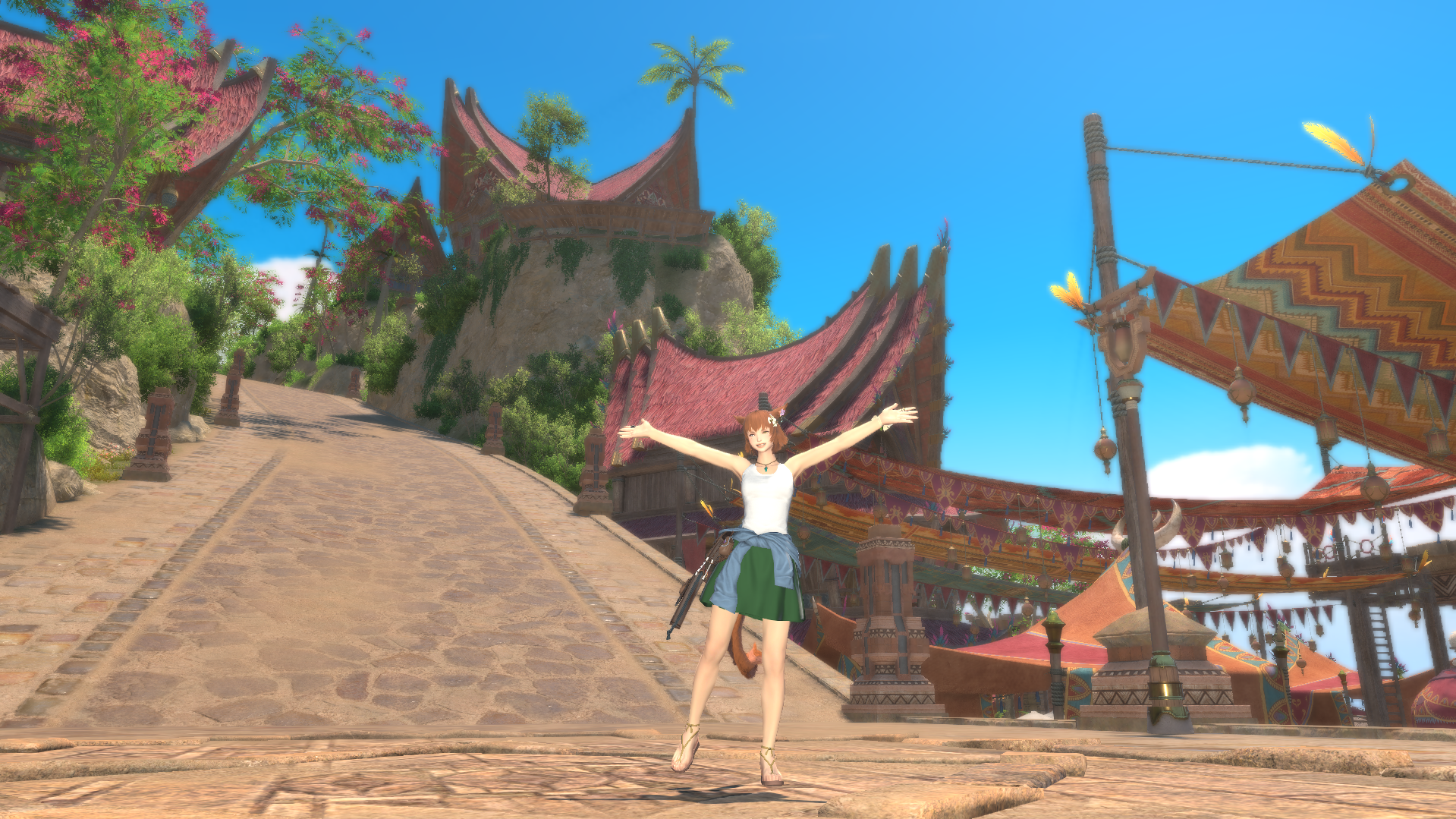
What I do, sadly, agree with is that much of the quest design of FFXIV feels extremely outdated and just a slog to get through. It feels like the vast, vast majority of quests I’ve done so far have boiled down to ‘Talk to Wuk Lamat’, run halfway across a town, talk to someone else, find some shinies on the ground, and complete the quest. There’s very little combat to be had outside of dungeons and trial boss fights, and what’s there is as bland as they come. When the cutscenes roll around, I’m generally pretty engaged with what’s happening, but there’s far too much downtime in between. Honestly, I’d rather be reading it as a visual novel than doing the most braindead actual questing - hell, I’d prefer the ‘collect ten bear asses’ style then just clicking on shines and waiting. Whilst this isn’t a recent issue in FFXIV - I’d make the argument that its quest design has always been on the weaker side - the general lower stakes and more relaxed pace of Dawntrail makes the issue more pronounced than ever before. I understand that it is hard to create a good quest that swings between the ‘collect ten bear asses’ and Dawntrail’s more simplistic quests, but I really do think Square Enix needs to find it.
However, in a wide break from tradition, the optional side quests introduced in Dawntrail are actually worth doing for, y’know, fun. This was kind of the case in Shadowbringers, but with Dawntrail taking place in a totally new continent with totally new cultures and races, getting to dive into its peoples and their traditions and daily lives is delightful. Plus, considering I’ve been leveling my Samurai class in the main story, using these side quests to level secondary classes works out real well. Honestly, whilst you’re generally doing hte exact same thing you’d be doing in the main story quests, but I suppose being able to do them at my leisure whilst learning about Dawntrail’s greatest strength - it’s cultures and people - makes them way more interesting than playing through the main story.
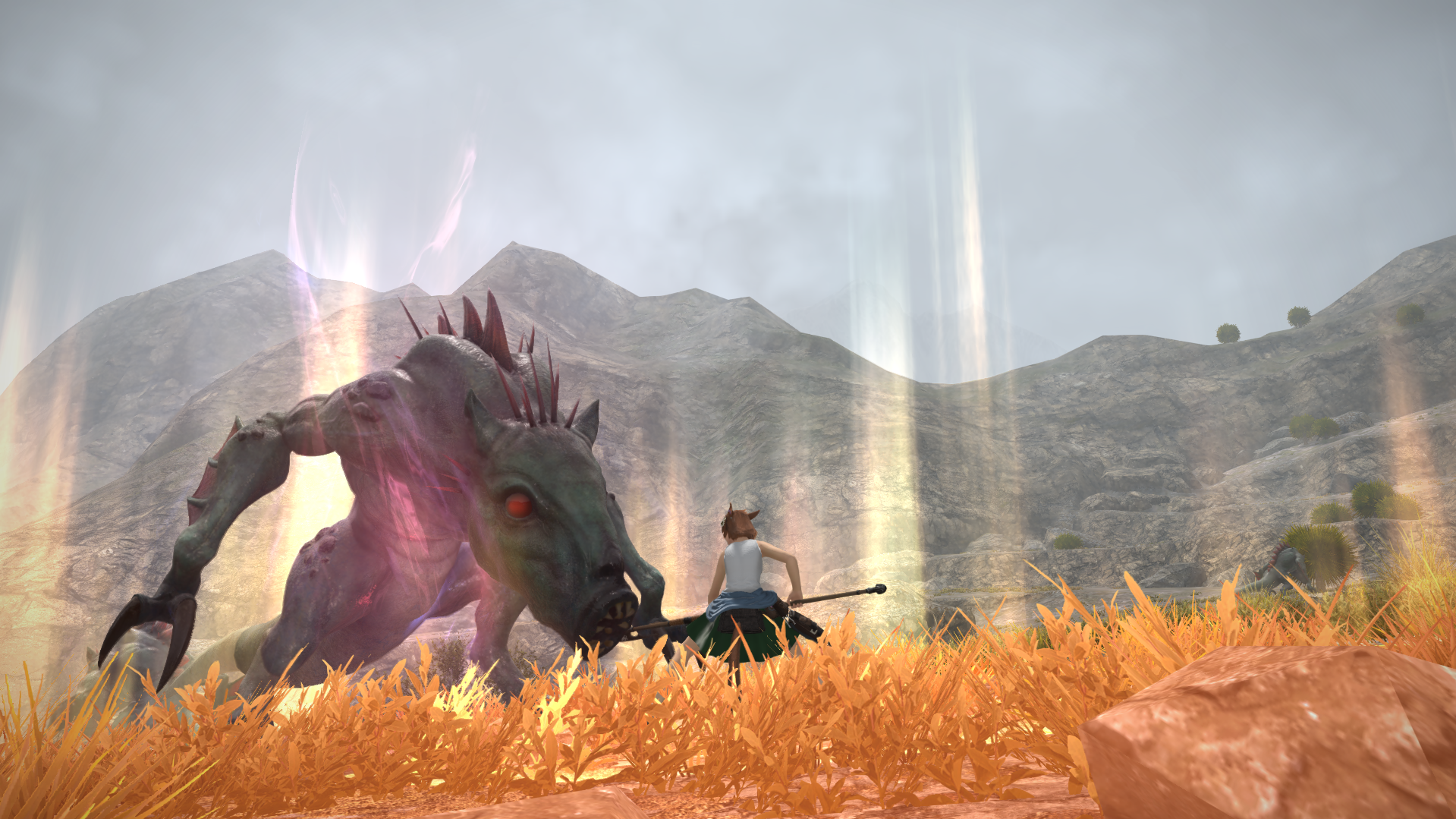
In a near mirror image situation, Dawntrail’s dungeons and trials is genuinely some of the best combat content FFXIV has ever produced. Constantly engaging, and challenging enough to keep you on your toes, Dawntrail has hit it out of the park. In particular, it’s first trial - the first major, 8-man boss fight - was an incredible audio-visual experience and being able to pull it off without dying - barely, at that - was so much fun. Sure, it’s cool that you can do these fights with NPCs now, but I can’t imagine doing that - seeing everyone learn together is half the fun for me! And I know, upon completing the main questline, harder difficulties of these fights get unlocked, and with how engaging these are already… man, I’ve never been one to grind away at hard content, but I think I NEED to try these Extreme Trials, and soon! As a member of a guild with friends who beelined the game, knowing that the later trials and dungeons only improve has me chomping at the bit - I’m forcing myself to write this before going back to it, so you can only imagine my excitement! With this fantastic foundation, I’ve never been so excited to play the harder content FFXIV has to offer, as the game has never felt as dynamic - and I’m only a third of the way through the main story!
Whilst I’m definitely in the most positive end of Dawntrail players, the expansion very much feels like a tale of duality. Parts of it are better than they’ve ever been - the instanced content has been fantastic, learning about the world of Dawntrail is engaging, and some of the zones are amongst the most beautiful in the game yet. On the other hand, the game’s already mediocre quest designs has never been so frustrating, nor the main quest so glacial. It certainly not a bad expansion, not by any stretch of the imagination, and I find it hard to be overtly angry at the game when the highs are so goddamn high. Still, as I’ve already said, I’m only a third of the way in, so we’ll see how things change as I move further. I can only hope that Yoshi-P and the rest of his team take the criticism to heart, as the quest design is one of the elements that holds me back from becoming a true FFXIV addict.
Expect to see a full Dawntrail review at some point!
